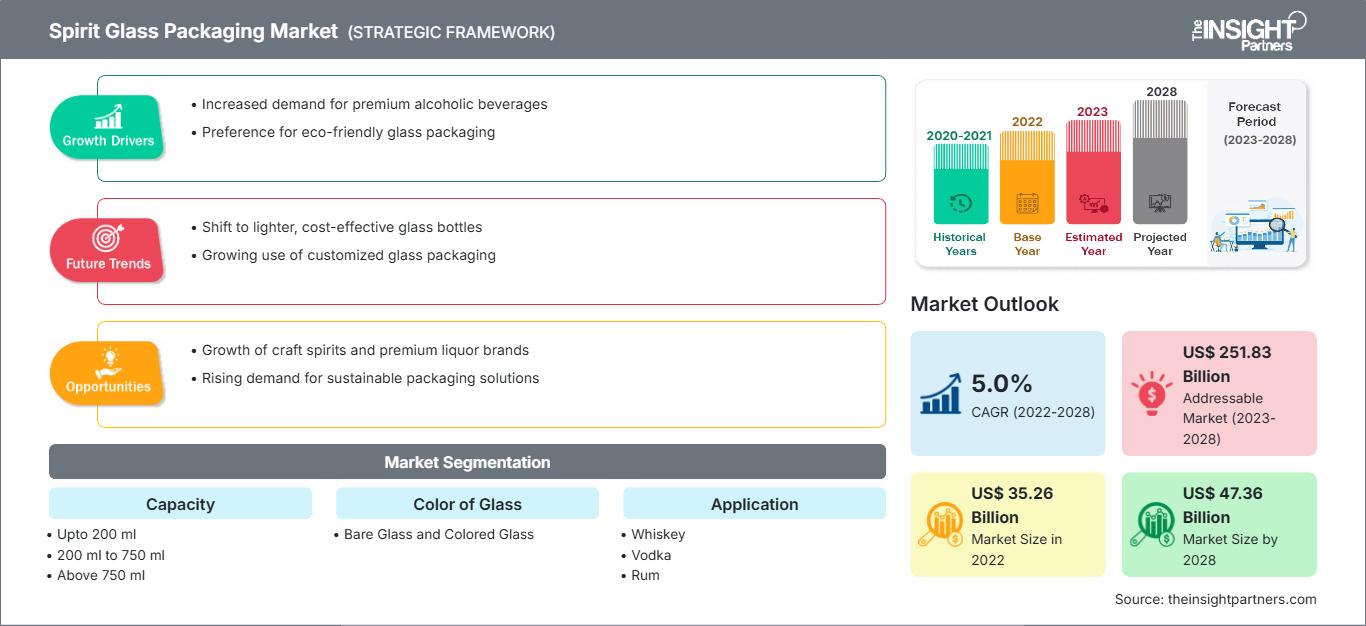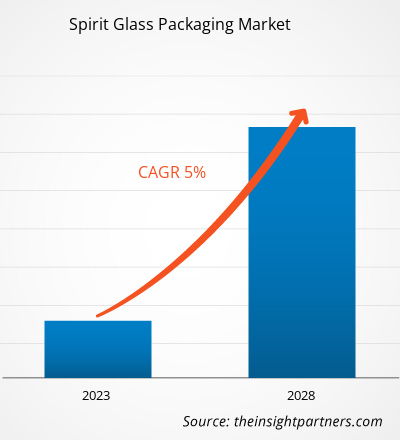[Informe de investigación] El tamaño del mercado de envases de vidrio para bebidas espirituosas se valoró en US$ 35.258,06 millones en 2022 y se espera que alcance los US$ 47.357,29 millones para 2028; se estima que registrará una CAGR del 5,0% de 2022 a 2028.
Los envases de vidrio para bebidas espirituosas se utilizan ampliamente en la industria para contener productos como vino, cerveza, ron, whisky y vodka, entre otros. La innovación en diferentes bebidas espirituosas, como los licores saborizados y el desarrollo de mezclas embotelladas, ha generado una gran demanda de envases de vidrio para bebidas espirituosas. Los envases de vidrio, con un diseño distintivo y una variedad de colores, mejoran la experiencia sensorial general e influyen en la decisión de compra del consumidor. El diseño y el tipo de envase de vidrio influyen positivamente en la imagen de marca, la diferenciación del producto y su aceptación y preferencia. La creciente preferencia del consumidor por los envases de vidrio ha impulsado a los fabricantes de bebidas espirituosas a ofrecer una diferenciación de productos mediante el diseño de envases y productos innovadores. Esto se debe a la disponibilidad de botellas de vidrio con bases gruesas, relieve y decoración, junto con el diseño de etiquetas; todas estas características proporcionan una imagen de marca armonizada y de alta calidad, y transmiten la historia de la marca o del producto.
En 2022, Asia Pacífico ostentaba la mayor cuota de mercado mundial en envases de vidrio para bebidas espirituosas. El crecimiento del mercado en Japón, India, China, Australia, Corea del Sur, Singapur, Taiwán e Indonesia se atribuye al creciente consumo de alcohol; al cambio en las preferencias de cervezas, whisky, vodka, vinos y otras bebidas espirituosas estándar a premium; al aumento de las celebraciones con bebidas alcohólicas; y a la innovación inusual de productos por parte de los fabricantes de bebidas espirituosas de la región. Por ejemplo, en septiembre de 2020, Scrapegrace Distillery, una destilería neozelandesa, elaboró la primera ginebra negra natural del mundo (bebida negra natural), elaborada con una mezcla de botánicos inusuales. Además, esta ginebra premium adquiere tonos rojizos y morados al mezclarse con tónica. La destilería vendió un suministro de tres meses del producto en 24 horas. A medida que las ventas de productos han aumentado, la demanda de envases de vidrio también ha crecido significativamente. Todos estos factores contribuyen al crecimiento del mercado de envases de vidrio para bebidas espirituosas en la región.
Obtendrá personalización en cualquier informe, sin cargo, incluidas partes de este informe o análisis a nivel de país, paquete de datos de Excel, así como también grandes ofertas y descuentos para empresas emergentes y universidades.
Mercado de envases de vidrio para bebidas espirituosas: Perspectivas estratégicas

- Obtenga las principales tendencias clave del mercado de este informe.Esta muestra GRATUITA incluirá análisis de datos, desde tendencias del mercado hasta estimaciones y pronósticos.
Impacto de la pandemia de COVID-19 en el mercado de envases de vidrio para bebidas espirituosas
La pandemia de COVID-19 tuvo un impacto significativo en el mercado de envases de vidrio para bebidas alcohólicas. Los confinamientos globales y las restricciones a los viajes y las reuniones sociales han provocado una disminución del consumo de bebidas alcohólicas, lo que ha provocado una disminución de la demanda de envases de vidrio para bebidas alcohólicas. Muchos bares, restaurantes y hoteles, clientes principales del sector HORECA, se vieron obligados a cerrar temporalmente o a operar con capacidad reducida, lo que ha provocado una menor demanda de botellas de vidrio de menor tamaño. Además, la interrupción de la cadena de suministro debido a las restricciones en el transporte y las operaciones de fabricación ha incrementado el coste de producción y distribución de envases de vidrio para bebidas alcohólicas.
En 2021, el mercado global comenzó a recuperarse de las pérdidas sufridas en 2020, gracias a que los gobiernos de diferentes países anunciaron la flexibilización de las restricciones sociales. Se permitió a los fabricantes operar a plena capacidad, lo que les ayudó a superar la brecha entre la oferta y la demanda. Además, el aumento de las tasas de vacunación contribuyó a mejorar las condiciones generales en diferentes países, lo que generó un entorno favorable para el progreso industrial y comercial. El aumento de la capacidad de producción de bebidas espirituosas en Asia Pacífico y Europa impulsó aún más la demanda de envases de vidrio para bebidas espirituosas en 2021.
Perspectivas del mercado
Crecimiento del sector HORECAHORECA Sector
El sector HORECA es uno de los principales usuarios finales de envases de vidrio para bebidas alcohólicas. HORECA se denomina Hotel/Restaurante/Catering y forma parte del segmento de servicios de alimentación, que incluye bares, pubs, cervecerías, clubes y hoteles, entre otros. El impacto de HORECA en los envases de vidrio para bebidas alcohólicas es significativo debido al gran volumen de productos que consume el sector. La preferencia de la población mundial por la comida y las bebidas para llevar y el aumento de la renta disponible están impulsando la industria HORECA en todo el mundo. Según la Asociación Nacional de Restaurantes (EE. UU.), las ventas de alimentos y bebidas del segmento de servicio completo (que incluye restaurantes familiares, informales y de alta cocina) crecieron de US$ 199 mil millones en 2020 a US$ 289 mil millones en 2022. En contraste, las ventas en EE. UU. del segmento de servicio limitado (incluidos restaurantes de comida rápida, restaurantes informales rápidos y cafeterías) aumentaron de US$ 297 mil millones en 2020 a US$ 355 mil millones en 2022. El informe reveló que las ventas de alimentos y bebidas en EE. UU. de bares, tabernas, clubes nocturnos o lugares involucrados en la preparación y servicio de bebidas alcohólicas crecieron de US$ 13 mil millones en 2020 a US$ 21 mil millones en 2022.
Perspectivas de capacidad
Según la capacidad, el mercado global de envases de vidrio para bebidas alcohólicas se segmenta en hasta 200 ml, de 200 ml a 750 ml y más de 750 ml. El segmento de 200 ml a 750 ml tuvo la mayor participación en el mercado global de envases de vidrio para bebidas alcohólicas en 2022. Esta categoría incluye botellas de vidrio con capacidades como 375 ml, 500 ml, 650 ml, 700 ml y 750 ml. Estos tipos de botellas de vidrio están disponibles en diversas formas y diseños. Además, vienen en diferentes colores, como marrón ámbar, blanco sílex, esmeralda, verde, azul zafiro, amarillo sol, negro lingote y gris plomo. Estas botellas de vidrio se utilizan principalmente para envasar brandy, ginebra, ron, tequila, vodka, whisky, vino, cerveza, etc. Las botellas de 375 ml y 650 ml se utilizan principalmente para envasar cerveza, mientras que las de 750 ml se utilizan principalmente para bebidas espirituosas como whisky, ginebra, ron, tequila y licores. Además, los fabricantes de vidrio para bebidas espirituosas se centran en crear botellas de vidrio atractivas de diversas capacidades que influyan en el precio de los productos y el comportamiento de compra del consumidor.
Entre los principales actores del mercado global de envases de vidrio para bebidas alcohólicas se encuentran OI Glass Inc., Toyo Glass Co. Ltd., Ardagh Group SA, Verallia SA, Vidrala SA, Gerresheimer AG, Nihon Yamamura Glass Co. Ltd., Vitro SAB de CV, BA Glass BV y HEINZ-GLAS GmbH & Co. KGaA. Estos actores se centran en ofrecer productos de alta calidad para satisfacer la demanda de los clientes. También se centran en estrategias como la inversión en investigación y desarrollo y el lanzamiento de nuevos productos.T
Informe destacado
- Tendencias progresivas de la industria en el mercado de envases de vidrio para bebidas espirituosas para ayudar a los actores a desarrollar estrategias efectivas a largo plazo.
- Estrategias de crecimiento empresarial adoptadas por los mercados desarrollados y en desarrollo
- Análisis cuantitativo del mercado de envases de vidrio para bebidas alcohólicas de 2020 a 2028
- Estimación de la demanda mundial de envases de vidrio para bebidas espirituosas
- Análisis de las cinco fuerzas de Porter para ilustrar la eficacia de los compradores y proveedores que operan en la industria
- Desarrollos recientes para comprender el escenario del mercado competitivo
- Tendencias y perspectivas del mercado, así como factores que impulsan y restringen el crecimiento del mercado de envases de vidrio para bebidas espirituosas.
- Asistencia en el proceso de toma de decisiones destacando las estrategias de mercado que sustentan el interés comercial, lo que conduce al crecimiento del mercado.
- El tamaño del mercado de envases de vidrio para bebidas espirituosas en varios nodos
- Descripción detallada y segmentación del mercado, así como la dinámica de la industria de envases de vidrio para bebidas espirituosas.
- El tamaño del mercado de envases de vidrio para bebidas alcohólicas en varias regiones con prometedoras oportunidades de crecimiento.
Perspectivas regionales del mercado de envases de vidrio para bebidas espirituosas
Los analistas de The Insight Partners han explicado detalladamente las tendencias regionales y los factores que influyen en el mercado de envases de vidrio para bebidas espirituosas durante el período de pronóstico. Esta sección también analiza los segmentos y la geografía del mercado de envases de vidrio para bebidas espirituosas en América del Norte, Europa, Asia Pacífico, Oriente Medio y África, y América del Sur y Central.
Alcance del informe de mercado de envases de vidrio para bebidas espirituosas
| Atributo del informe | Detalles |
|---|---|
| Tamaño del mercado en 2022 | US$ 35.26 mil millones |
| Tamaño del mercado en 2028 | US$ 47.36 mil millones |
| CAGR global (2022-2028) | 5.0% |
| Datos históricos | 2020-2021 |
| Período de pronóstico | 2023-2028 |
| Segmentos cubiertos | Por capacidad
|
| Regiones y países cubiertos | América del norte
|
| Líderes del mercado y perfiles de empresas clave |
|
Densidad de actores del mercado de envases de vidrio para bebidas espirituosas: comprensión de su impacto en la dinámica empresarial
El mercado de envases de vidrio para bebidas espirituosas está creciendo rápidamente, impulsado por la creciente demanda del usuario final debido a factores como la evolución de las preferencias de los consumidores, los avances tecnológicos y un mayor conocimiento de los beneficios del producto. A medida que aumenta la demanda, las empresas amplían su oferta, innovan para satisfacer las necesidades de los consumidores y aprovechan las tendencias emergentes, lo que impulsa aún más el crecimiento del mercado.

- Obtenga una descripción general de los principales actores clave del mercado de envases de vidrio para bebidas espirituosas
Mercado mundial de envases de vidrio para bebidas espirituosas
Según la capacidad, el mercado global de envases de vidrio para bebidas alcohólicas se segmenta en hasta 200 ml, de 200 ml a 750 ml y más de 750 ml. Según el color del vidrio, se divide en vidrio desnudo y vidrio coloreado. Según la aplicación, se segmenta en whisky, vodka, ron, vino, cerveza y otros.
Perfiles de empresas
- OI Glass Inc
- Toyo Glass Co. Ltd.
- Grupo Ardagh SA
- Verallia SA
- Vidrala SA
- Gerresheimer AG
- Compañía de vidrio Nihon Yamamura Ltd.
- Vitro SAB de CV
- BA Glass BV
- HEINZ-GLAS GmbH & Co. KGaA.
- Análisis histórico (2 años), año base, pronóstico (7 años) con CAGR
- Análisis PEST y FODA
- Tamaño del mercado, valor/volumen: global, regional y nacional
- Industria y panorama competitivo
- Conjunto de datos de Excel
Informes recientes
Informes relacionados
Testimonios
Razón para comprar
- Toma de decisiones informada
- Comprensión de la dinámica del mercado
- Análisis competitivo
- Información sobre clientes
- Pronósticos del mercado
- Mitigación de riesgos
- Planificación estratégica
- Justificación de la inversión
- Identificación de mercados emergentes
- Mejora de las estrategias de marketing
- Impulso de la eficiencia operativa
- Alineación con las tendencias regulatorias




















 Obtenga una muestra gratuita para - Mercado de envases de vidrio para bebidas espirituosas
Obtenga una muestra gratuita para - Mercado de envases de vidrio para bebidas espirituosas